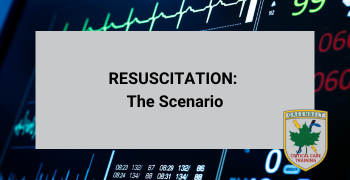
RESUSCITATION: the SCENARIO
Learning through realistic, high-pressure scenarios is the best way to prepare for real-life emergencies.
Welcome to the Drama!
Whatever program you are taking with us, scenarios are an integral part of the courses we offer. We help you with your communication skills and provide valuable feedback from your team. Feedback occurs in the debriefing as well. It's not necessarily about what you did wrong, but exploring other options you could have taken to achieve the same or even a better outcome for your patient.
At Greenbelt ACLS, we believe that learning through realistic, high-pressure scenarios is the best way to prepare for real-life emergencies. Whether you're enrolled in our ACLS, PALS, PEARS, or SIM courses, you'll find that scenarios play a crucial role in our training methodology.

With that said, here are 5 benefits of practicing with scenarios for critical care! 👊
1. Real-Life Simulations
Imagine being in the middle of a bustling ER when a patient suddenly goes into cardiac arrest. The room fills with the sound of alarms, and every second counts. This is the kind of intense, real-life scenario we bring into our training sessions. Our goal is to replicate the urgency and unpredictability of real medical emergencies so that you can practice your response in a safe, controlled environment.
2. Enhancing Communication Skills
One of the most critical aspects of any resuscitation effort is effective communication. In the heat of the moment, clear and concise communication can be the difference between life and death. During our scenarios, you'll have the opportunity to refine these skills, working closely with your team to ensure that everyone is on the same page and that instructions are both given and received effectively.
3. Constructive Feedback
After each scenario, we hold a debriefing session where you and your team can reflect on the experience. This isn't just about pointing out mistakes; it's about exploring different strategies and understanding the impact of your decisions. We focus on providing constructive feedback that highlights other options you could have considered, helping you to see how these choices might lead to better outcomes for your patients.
In our debriefing sessions, we emphasize that there's no single 'right' way to handle a situation. Instead, we explore a range of possible approaches and their potential outcomes.
4. The Power of Debriefing
Debriefing is where the magic happens. It's your chance to take a step back and analyze the scenario from multiple angles. What went well? What could have been done differently? How did your team dynamics play out? This reflective process is vital for deep learning and helps cement the lessons learned during the simulation.
5. Continuous Improvement
Resuscitation scenarios aren't just about practicing procedures; they're about continuous improvement. Each scenario is an opportunity to hone your skills, build your confidence, and become more adept at handling high-pressure situations. With each iteration, you'll find yourself becoming more proficient and more prepared to face real-life emergencies.
At Greenbelt ACLS, we are committed to providing the highest quality training to ensure that you are ready to save lives when it matters most. So, welcome to the drama! Embrace the scenarios, engage with your team, and take advantage of the debriefing process to become the best healthcare provider you can be.
For more information about our courses, or to register for an upcoming training, visit GreenbeltACLS.com/trainings.
Let’s make a difference, one scenario at a time.